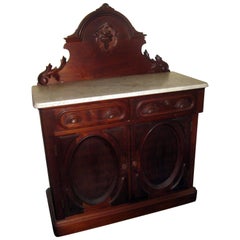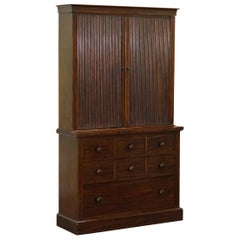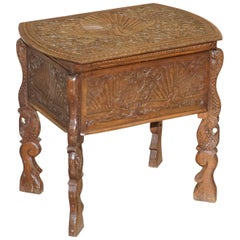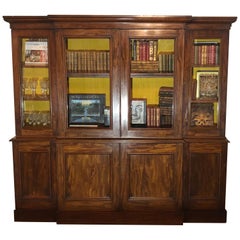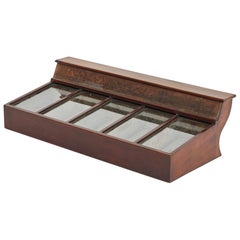19th Century Cupboards
1
74
to
7
57
15
74
74
74
74
31
23
20
17
16
15
14
12
8
8
4
1
1
2
74
4
Height
to
Width
to
Depth
to
73
27
26
17
11
68
53
35
4
3
2
1
1
1
1
Style: Victorian
Period: 19th Century
19th century Victorian Walnut Server Sideboard with Marble Top
Located in Savannah, GA
Lovely Victorian walnut server or sideboard with beveled marble top. Two drawers, one divided for silverware. Two doors below with divided shelf. Nice petite size suitable for dining...
Category
American High Victorian Antique 19th Century Cupboards
Materials
Marble
Very Rare Victorian Tambour Door Cupboard Bookcase on Bank Chest of Drawers
Located in GB
We are delighted to offer for sale this very rare Victorian tambour door cupboard and bank of drawers
I have never seen another cupboard like this, tambour drawers are almost alwa...
Category
English Victorian Antique 19th Century Cupboards
Materials
Hardwood
Burmese Hand Carved Peacock Sewing Table Cupboard Chest Open Top, circa 1880
Located in GB
We are delighted to offer for sale this absolutely stunning original circa 1880 Burmese hand carved sewing side table or little chest with lovely peacock design
A very good lookin...
Category
Burmese Victorian Antique 19th Century Cupboards
Materials
Wood
19th Century English Victorian Mahogany Bookcase
Located in Miami, FL
A beautiful antique early 19th century Victorian bookcase, masterfully crafted in rich solid mahogany, circa 1850.
This bookcase featu...
Category
English Early Victorian Antique 19th Century Cupboards
Materials
Mahogany
Rare Moses Michelangelo Guggenheim & Pauly Cie Et Venice Antique Carved Armoire
Located in GB
We are delighted to offer for sale this very rare one of a kind Pauly CIE Et stamped hand carved walnut armoire made by the genius that was Moses Michelangelo Guggenheim 1837-1910
Where to begin, this cabinet is stamped to the rear “Fabrique De Meubles Pauly & Cie Venise. Pauly & Cie” who were a world famous glass foundry and later equally famous furniture manufacturer. Their grotto furniture has an immense following across the world. This piece was most likely retailed through them as it was made by Moses Michelangelo Guggenheim who is a fellow venetian
There is one other known example of his works which is very similar, it is currently retailing for no less than £900,000 however it is accompanied by a few other pieces from a drawing room suite. The suite came from Palazzo Papadopoli, a Renaissance palace on the Grand Canal in Venice built for the Coccini family by Giovanni de Grigi around 1560. I will include some further history below on both Pauly CIE ET and Moses Michelangelo Guggenheium
On to the armoire, it is clearly the most ornate tour de force of carving you will ever see, I’m thankful it has managed to survive so long without being broken up by salvagers looking to reclaim the sculptures. You can see in the carving elements of Pauly’s inspiration in the form of shells. You also have Putti’s riding dolphins and so on. We have fully treated it as there were various signs of old worm, it’s then been cleaned waxed and polished. One of the hidden hinges has been replaced, otherwise it is in near perfect condition for the age. The insides houses three wood shelves
Dimensions
Height 255.5cm top to bottom, without the removable top carving 211cm
Width 170cm arm to arm of the chaps on the outside, 172cm at the top, 166cm at the bottom
Depth 63cm top, 55cm middle, 59cm bottom
Please note all measurements are taken at the widest point
Moses Michelangelo Guggenheim
Leading expert of decorative arts in late 19th century Venice, Michelangelo Guggenheim (1831-1910) also was one of the greatest antiquarians and a modern furniture producer in the “City of Water”. His collections stored in the Balbi Palace on the Grand Canal were an outstanding sight, that art amateurs would recommend.
At the age of 20, he founds a "Stabilimento d’arti decorative e industriali" which purpose is the industrial creation of objects bearing an artistic force. The furniture that made him worldwide famous re-imagines ancient styles, freeing their aesthetic powers to serve modern imagination. Often in walnut, his pieces of furniture sent to World Fairs impress people by the finesse of their sculptures.
A prized designer as well, he reorganizes princely interiors in the same spirit. His most famous work is the Palazzo Papadopoli's design about 1874, where he unfolds the vocabulary of several periods. He conceives there a richly furnished Neo-Renaissance Cabinet that relived the Italian golden age. For the exceptional result he is awarded the Gold Medal of merit for science and arts by Ludwig II of Bavaria.
Pauly & Cie Venise
Since its foundation (1866), Pauly & C. has stood for elegance, creativity and Venetian luxury. The ancient Roman technique known as “murrine”, which today is the symbol of Murano glass, was reproduced for the first time in its workshops and was presented to the world at the Universal Exhibition in Paris in 1878.
In 150 years of business Pauly & C. has produced unique works for royal palaces, public buildings, private villas and has served an international client base that includes some of the most prominent names from the world of culture and art, figures from the world of industry and finance, politicians and nobility.
Pauly & C. - C.V.M. (compagnia Venezia Murano) works are currently held in many private collections and exhibited in some of the most prestigious museums in the world.
In the last years of activity, Pauly has been active with three distinct brands: • Pauly & C. CVM, the time-honoured company that produces classic objects, recreating old designs and collections and offering modern reinterpretations of them. • Pauly Glass Factory, which continues its association with artists and designers to produce artistic works with modern lines. • MVM Interior operates throughout the world with architects, interior designers and design studios for the creation of prestigious personalized projects
History
Compagnia di Venezia e Murano C.V.M. began as Salviati &C. in London in 1866 under the direction of Vicenza attorney Antonio Salviati and with the backing of two British men: archaeologist Austen Henry Layard and antiquarian Sir William Drake.
The company was dedicated to using ancient techniques and utilized master glassblowers in its efforts to do so. It called in specialists from other fields like goldsmithing and engraving to ensure authenticity and employed artist Giuseppe Devers to teach the techniques of enamelling and heat-applied glass gilding to company artisans.
Archaeologist Layard was particularly interested in the mosaic glass techniques of Roman and pre-Roman artists, and he spent years personally overseeing the work of the company's technicians and glassblowers in attempting to revive those techniques. In 1872, the company was successful, managing to replicate the type of glass commonly known as "murrina". The company was renamed Venice and Murano Glass and Mosaic Company Limited in 1872, and, in 1877, Layard purchased Salviati's interest so that Salviati could pursue other interests.
The company quickly earned a reputation for quality original glass art and reproductions as well as its many mural mosaics in Great Britain and elsewhere in Europe. In 1878, the murrine produced by Compagnia di Venezia e Murano was included in its exhibit at the International Exhibition in Paris, which was the chief attraction in Italian glass. In its observations of the display, the United States Commission to the Paris exposition commented not only on "Roman murrine glass", but also particularly on the mural glass mosaics, the "perfection of which" had "engaged the earnest attention of the company." Mosaics produced by the company during the time period are still in existence in diverse areas such as Gonville and Caius...
Category
Italian Victorian Antique 19th Century Cupboards
Materials
Walnut
19th Century English Display Case in Mahogany
Located in Los Angeles, CA
Commercial display case with mahogany siding from 1870s England. A row of five rectangular glass-lidded compartments makes a unique opportunity for the d...
Category
English Late Victorian Antique 19th Century Cupboards
Materials
Mahogany
1840 Italain Venetian Cabinet on Stand Polychrome Painted & Lion Heads Carvings
Located in GB
We are delighted to offer for sale this sublime circa 1840 Italian Venetian Polychrome painted cabinet on stand with Lion head carved silver l...
Category
Italian Early Victorian Antique 19th Century Cupboards
Materials
Oak
Lovely Hand Carved Solid Oak Dutch Cupboard Ornate Detailing Chest of Drawers
Located in GB
We are delighted to offer for sale this stunning original early 19th century hand carved Dutch cupboard
A very good looking and well made piece, ornately carved and nicely detaile...
Category
Dutch Victorian Antique 19th Century Cupboards
Materials
Oak
Lovely Anglo Burmese 19th Century Hand Carved Sideboard with Drawers & Cupboards
Located in GB
We are delighted to offer for sale this stunning 19th century Anglo Burmese hand carved sideboard with drawers and cupboards
A highly decorative and w...
Category
East Asian Victorian Antique 19th Century Cupboards
Materials
Wood
Wilhelminian antique Style Cupboard with Small Green Glass, circa 1880 oak
Located in Berlin, DE
Here we offer you a truly incredible Wilhelminian cabinet with the finest epoch-style styling features.
Massive oak manufactured circa 1900 impresses among other things by its car...
Category
German Victorian Antique 19th Century Cupboards
Materials
Oak
19th century American Victorian Walnut Cupboard
Located in Savannah, GA
Very ornate walnut cupboard with three shelves with glass doors on the upper case. On top, the cornice features a reticulated crown with carve...
Category
American High Victorian Antique 19th Century Cupboards
Materials
Brass
Early Victorian Goncalo Alves Chiffonier
Located in Whaley Bridge, GB
J0 Very unusual Goncalo Alves tall chiffonier, having mirrored back with 3 shelves, carved up-stand and shaped supports over stunning top with secret fri...
Category
English Early Victorian Antique 19th Century Cupboards
Materials
Wood
Victorian Walnut Library Cabinet
Located in Lymington, Hampshire
This walnut cabinet has a shaped, stepped top above a central glazed door enclosing four Moroccan leather drawers with cedar linings. Flanked by eight smaller disguised drawers, the ...
Category
English Victorian Antique 19th Century Cupboards
Materials
Walnut
English Elm Corner Cupboard
Located in Woodbury, CT
English elm corner cupboard with ebonized recessed panel frames, single drawer, plinth base. Overall, a nice, "country elegant" look with chamfered sides a...
Category
British Victorian Antique 19th Century Cupboards
Materials
Elm, Pine
English Walnut and Marquetry Davenport Desk, 19th Century
Located in London, GB
Constructed in Circassian walnut, with line and marquetry inlays; rising from turned oblate bun feet; the lower section housing a hinged door with fretwork panelling, opening to reveal four lemonwood faced graduated drawers with inset turned knobs; the writing compartment braced by foliate spandrels above and below, the slide opening to reveal an easel support writing slope with inset tooled leather and a pen and ink tray...
Category
English Victorian Antique 19th Century Cupboards
Materials
Walnut, Leather
English Painted Housekeepers Cupboard
Located in Leamington Spa, Warwickshire
Large English antique painted pine housekeepers cupboard. Great storage. 1850.
Reference: 7819
Dimensions
82 inches (208 cms) wide
21.5 inches (55 cms) deep
95 inches (241 c...
Category
English Victorian Antique 19th Century Cupboards
Materials
Pine
Recently Viewed
View AllMore Ways To Browse
Old Antique Kitchen Cupboard
Kitchen Wall Cupboard
Antique Rustic Cupboard
Antique Wall Cupboard Cabinets
Cupboards with Glass Doors
Antique Wall Cabinet Cabinets And Cupboards
Antique Wall Cupboard Cabinets And Cupboards
Antique Solid Wood Cupboard
Antique Country Cupboard
Carved Mid Century Cupboard
Italian Mid Century Cupboard
Antique Cabinet Canada
French Louis Xv Cupboard
Antique Step Back Cabinet
Green Painted Cupboard
Antique Step Back Cabinets
Antique Pantry
Kitchen Cupboard Georgian
